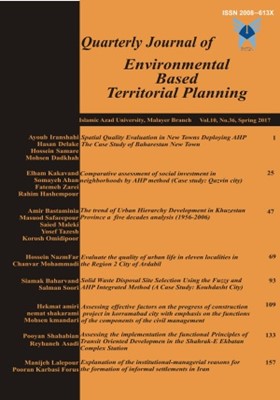Spatial Qualities Evaluation in New Towns Using (AHP) The Case Study of Baharestan New Town
Subject Areas :Ayoub Iranshahi 1 , Hasan Delake 2 , Hossein Samare 3 , Mohsen Dadkhah 4
1 - MA in Urban Design, Isfahan University of Art
2 - MA student in Urban Design, Isfahan University of Art,
3 - MA student in Urban Design, Isfahan University of Art
4 - MA in Urban Design, Isfahan University of Art
Keywords: New city, urban space qualities, AHP technique, Baharestan,
Abstract :
In recent years, the population of metropolitans and large cities of Iran has had an increasing growth. This has caused irreparable damages to the economic, social, natural and ecologic infrastructure and foundations of those cities. Following the irregular population growth, new cities have been built to lower the population rate in metropolitans and to create employment opportunities. However, inattention to the qualities of urban spaces due to hasty construction and a rapid overflow of metropolitan population has created new cities favorable quality of urban and social life. Even in some cases the result has been deserted and with-no-identity cities Baharestan new town, located in the proximity of the ancient city of Isfahan, through its fitting natural potential and appropriate ecologic characteristic, can help considerably in reducing the population growth of Isfahan metropolitan and lowering economic and employment pressure on this city. The present study, after scrutinizing definitions and concepts of qualities of urban spaces and their relation and influence on other qualities presented by leading researchers of the field, came up with the most principal qualities effective in setting up new cities according to professors and experts’ opinions extracted using a questionnaire. Subsequently, using AHP method and Expert Choice software, this research assessed and measured the extracted principal qualities in the Baharestan new town. The results identified variability, efficiency, the sense of attachment, readability and vitality as principal qualities, all of which were at a relatively inappropriate condition and lower than average in Baharestan. The quality of variability was observed to be at a lower level than other qualities.
- احدنژاد، م، زلفی،ع، نوروزی، م. 1392. تحلیلی بر مکانیابی اراضی بهمنظور استقرار صنایع با استفاده از روشAHP و VIKOR، نمونه موردی بخش مرکزی منطقه آزاد ارس. فصلنامه جغرافیایی آمایش محیط، شماره 24: 82-63
- امینی، ا، برومند، م، روحافزا، ا. 1392. ارزیابی عوامل مؤثر برافزایش کیفیت فضاهای عمومی در شهرهای جدید، نمونه موردی شهر جدید پرند. فصلنامه جغرافیایی آمایش محیط، شماره 26: 110-89
- بزی، خ، افراسیابی راد، م. 1388. سنجش و ارزیابی میزان موفقیت و کارایی شهرهای جدید؛ مطالعات موردی شهر جدید صدرا. مطالعات و پژوهشهای شهری و منطقهای، شماره 2: 134-111
- بهزادفر، م، رزاقی اصل، س. 1388. سامان نقد کیفی توسعه شهرهای جدید مبتنی بر رویکردهای طراحی شهری. فصلنامه آبادی، شماره 30: 59-50
- بنتلی، ا. 1392. محیطهای پاسخده. مصطفی بهزادفر. چاپ نهم. انتشارات دانشگاه علم و صنعت ایران. 58-21
- پاکزاد، ج. 1382. عناصر و کیفیتهای یک فضای شهری. فصلنامه آبادی. شماره 38
- تیبالدز، ف. 1387. شهرسازی شهروندگرا. محمد احمدینژاد. انتشارات خاک. 89-88
- جوان فروزنده، ع، مطلبی، ق. 1390. مفهوم حس تعلق به مکان و عوامل تشکیل دهنده آن. هویت شهر، شماره 8: 37-27
- جیکوبز، ج. 1392. مرگ و زندگی شهرهای بزرگ آمریکا. حمیدرضا پارسی و آرزو افلاطونی. چاپ سوم. انتشارات دانشگاه تهران. 199-197
10. رفیعیان، م، مولودی، ج. پورطاهری، م. 1390. سنجش کیفیتهای محیط شهری در شهرهای جدید، مطالعه مورد شهر جدید هشتگرد. برنامهریزی و آمایش فضایی، شماره 3: 38-19
- رلف، ا. 1390. مکان و بیمکانی. زهیر متکی، محمدرضا نقصان محمدی و کاظم ماندگاری. انتشارات آرمانشهر. 25
- زارع شاهآبادی، ا. 1375. جامعهشناسی شهرهای جدید نقدی بر پدیدهی شهرهای جدید در ایران. فصلنامه جمعیت، شماره 17
- سعیدنیا، ا. 1382. کتاب سبز شهرداری (کاربری زمین شهری). انتشارات سازمان شهرداریها. 97-72
- سیفالدینی، ف.1385. فرهنگ واژگان برنامهریزی شهری و منطقهای. انتشارات آییژ.11-9
- شرکت عمران شهر جدید بهارستان، 1372. طرح جامع بهارستان توسط مشاورین نقش جهان پارس.
- شوای، ف. 1392. شهرسازی: تخیلات و واقعیات. سید محسن حبیبی.چاپ ششم. انتشارات دانشگاه تهران. 126
- قدسی پور، ح. 1392. فرآیند تحلیلی سلسلهمراتب (AHP). چاپ چهارم. تهران: انتشارات امیرکبیر.
- قرخلو، م، شعبانی فرد، م، حسینی، ع، احدزاده، ث. 1388. جایگاه شهرهای جدید در توسعه مسکن. مسکن و محیط روستا، شماره 125: 35-18
19. عزت پناه، ب، شگوری، م، مددی، ا. 1392. مدلسازی مکانیابی پارکینگهای طبقاتی با استفاده از روش AHP و شاخص همپوشانی وزنی در محیط GIS، مطالعه موردی منطقه 2 اردبیل. فصلنامه جغرافیایی آمایش محیط، شماره 27: 20-1
20. عزیزی، م. 1389. تراکم و کاربردهای آن در شهرسازی؛ اصول و معیارهای تعیین تراکم. چاپ چهارم. انتشارات وزارت مسکن و شهرسازی. 115
21. کارمونا، م. 1391. مکان عمومی فضاهای شهری، ابعاد گوناگون طراحی شهری. فریبا قرایی، مهشید شکوهی و دیگران. انتشارات دانشگاه هنر. 54
- گل، ی. 1387. زندگی در فضای میان ساختمانها. شیما شصتی. چاپ اول. انتشارات سازمان انتشارات جهاد دانشگاهی. 34-16
- لینچ، ک .1390. تئوری شکل خوب شهر. سید حسین بحرینی. چاپ پنجم. انتشارات دانشگاه تهران. 125-103
- مرصوصی، ن، بهرامی، ر. 1390. توسعه پایدار شهری. انتشارات دانشگاه پیام نور تهران.
- مهدیزاده، ج. 1380. بهسوی شهرسازی دموکراتیک. فصلنامه مدیریت شهری، شماره5: 44
- معاونت برنامهریزی و نظارت راهبردی ریاست جمهوری.1390. نتایج سرشماری نفوس و مسکن مرکز آمار ایران.
- نصیری، ا. 1394. برنامهریزی شهرهای جدید. انتشارات دانشگاه پیام نور.
- وارثی، ح، علی زاده، ج، صالحی، م. 1390. تحلیل و ارزیابی احساس هویت ساکنین در شهرهای جدید (نمونه موردی شهر جدید فولادشهر). برنامهریزی فضایی، شماره 3: 62-37
- یاران، ع، محمدی خوشبین، ح. 1391. بررسی خودکفایی در شهرهای جدید مقایسه تجربه ایران (شهر جدید هشتگرد) و کره جنوبی. نشریه علمی پژوهشی انجمن علمی معماری و شهرسازی ایران، شماره 4: 112-99
- Appleyard, D., Gerson, M., Lintell,M. 1982. Livable Streets. University of California Press
- Kamp, I., Leidelmeijer, K., Marsman, G., Hollander,A. 2003. Urban environmental quality and human well-being towards a conceptual framework and demarcation of concepts; a literature study.Landscape and Urban Planning, 65:5-18
32. Saaty, T. 1980. The Analytic Hierarchy Process: Planning. Priority Setting, Resource Allocation, RWS Publications, USA.173-189


